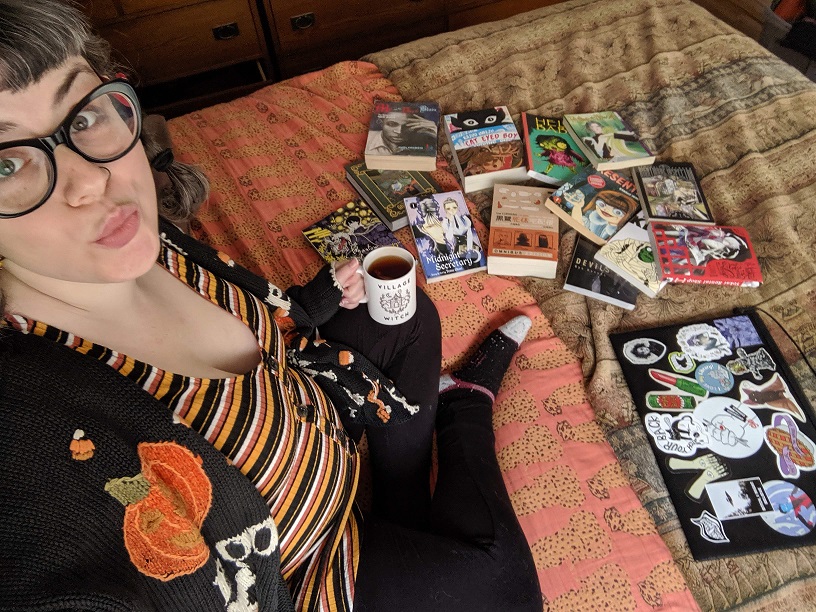We all have those artists whose work we keep intending to read, but somehow they keep getting put off for one reason or another. For me, that was Ronald Wimberly, specifically his book Prince of Cats. I knew that I had to fill that gap in my comics reading, and so this second Black Creator Spotlight centers on Wimberly.
Ronald Wimberly is an award-winning comics artist whose work includes the aforementioned Prince of Cats, Black History In Its Own Words, and the ongoing LAAB project. LAAB is, in the words of its most recent Kickstarter campaign: “An annual broadsheet magazine full of art, comics, criticism, interviews.” When I was working at Comicopia, we got a stack of the first issue, and I was very impressed with the cohesiveness, clarity, and design sense of the magazine. Wimberly brings together many voices to talk on issues that are important to him, including Black identity. I had never seen anything like it in comics, and haven’t seen anyone doing something similar, either.
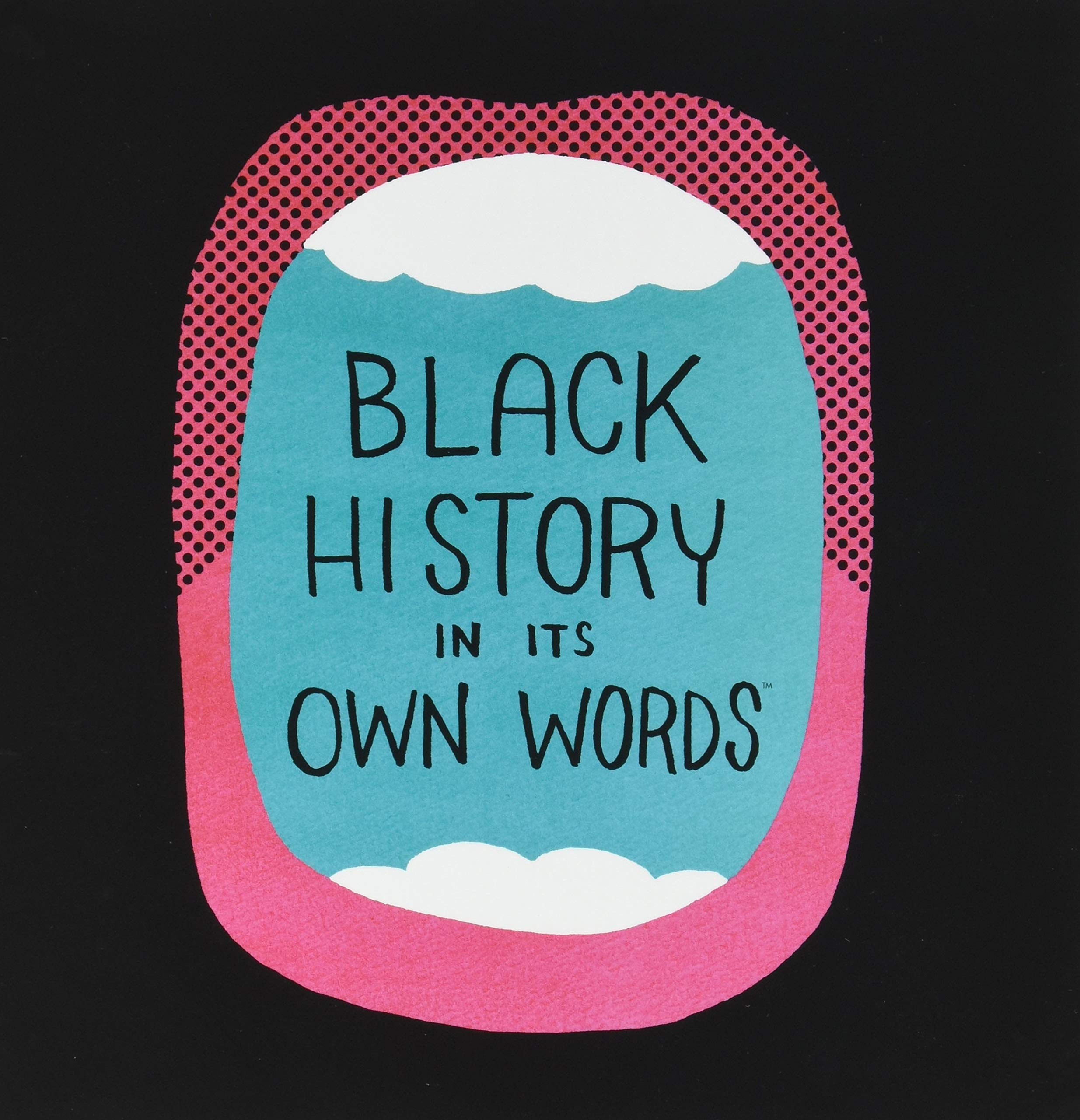
I had read Wimberly’s Black History In Its Own Words a while ago, and I knew that I loved his artwork. I’ve since reread it for this post, and I have a more informed perspective on it in the face of current events and conversations around anti-racism. In short, the book is a compilation of portraits of influential Black people, accompanied by quotes that Wimberly found meaningful. Initially begun as a project for The Nib for Black History Month, Wimberly spun it out into a whole book to be published by Image Comics — drawings spanning three years of work. I especially appreciate that not all of the figures profiled are names well-known to the average white reader; Wimberly purposefully includes rappers, artists, and radical feminists in the mix of voices. I remember being surprised to learn that George Herriman, the creator of Krazy Kat, was a Black man; as in so many aspects of my life, I assumed a white default. When I first read this book, I think I considered it a cute quote book with exceptional artwork; now I realize that Wimberly was collecting a medley of Black voices for Black empowerment and reflection on Blackness. For me as a white woman, the book is an important reminder that even though it is not “for me,” there is plenty for me to learn from it, and from the wealth of influential Black figures both past and present.
Prince of Cats made me glad that I was forced to read Romeo & Juliet multiple times — a feat which middle and high school English classes could never achieve. Wimberly recasts the play with all Black characters, sets it in 1980s New York City, and centers his narrative on Tybalt. He mixes Shakespeare’s lofty prose with street talk in a melodious marriage that reinforces the Bard’s own sense of humor at times. (“Redeem thy kicks for thy skin.”) I found myself thinking of the 1996 movie adaptation of the play starring Leonardo DiCaprio a lot during this reading; Wimberly sets a stage that is more easily recognizable to a modern audience, and changes perspective to highlight the destruction of seemingly arbitrary demarcations of difference. The gang violence portrayed seemed much more real and pressing to me than the fruitless feud of the Montagues and Capulets in Shakespeare’s original play.

And of course, Prince of Cats is visually incredible. Because of time constraints, I borrowed a digital copy of the comic from my library, even though it is not my preferred method of reading comics. The digital version has a unique feature that forced me to read most of the comic panel by panel, instead of page by page. Generally I take issue with this, because I know that artists put as much effort into page and panel layout as the illustrations themselves, and I know from LAAB that Wimberly has a strong sense of graphic design; however, this allowed me to get a much closer look at the little details he puts in every drawing. I love his use of thick black lines, his sense of movement. I was especially excited by the visual references to Japanese culture, including a few specifically to Akira. Prince of Cats is a celebration of Shakespeare, but also of hip-hop, samurai films, animation, and Blackness. It’s not a straight adaptation, but rather a work that breathes new life and meaning into what can feel like a stale play to many readers. (But maybe I’m biased; I prefer Hamlet.)
Wimberly recently had a comic of his pulled from the New York Times for its “controversial” image of a burning cop car. This page was the end of a series of diary comics, and it is disappointing (to say the least) that the Times decided that Wimberly’s very real, raw emotions about police brutality were deemed inappropriate. For those who want to experience more of Wimberly’s personal comics, and his ongoing work through LAAB, you can subscribe to his Patreon (where membership levels are “Alibi,” Co-defendant,” and “Co-conspirator”), follow him on Instagram, and/or follow him on Twitter.
[Note: Wimberly does not have direct links to purchase Black History In Its Own Words or Prince of Cats through his own website or social media profiles. Instead of linking to their Image Comics pages, I encourage interested readers to get in touch with Amalgam Comics & Coffeehouse, a Black woman owned comic shop out of Philadelphia, PA. Their website says that Prince of Cats is currently out of stock, but many shops are willing to place special orders for customers. And regardless, they’re a good shop to support!]
Uncategorized
Black Creator Spotlight: Bianca Xunise
I’m kicking off the Black Creator Spotlight with a profile on Bianca Xunise, a Chicago-based artist whom I have followed on Twitter and Instagram for years now. I initially began following her because of her involvement in the Chicago goth scene, and for her punk and goth related jokes, outfits, and musings. In the course of the last few years, I have been treated to her comics as well, many which center around her experiences with racism, sexism, and mental health. Xunise is a cartoonist whose work has appeared in many places including Vogue and The Washington Post, though you may recognize it most readily from The Nib.
A few weeks ago, I finally purchased four of Xunise’s mini-comics through her Gumroad: The Ignatz Award-winning Say Her Name, Rock Against Racism, GothThrob Magazine #1, and The Devil’s Music. Having paid attention to her posts, I knew what to expect and that I would enjoy it. In fact, I hope to one day re-purchase all four, along with more of her other works, in a physical format.
Xunise’s artwork reminds me, favorably, of Charles Schultz’s Peanuts. Her figures have sweet round faces and the easily readable facial expressions that are essential to the cartoon medium. A major important difference is that Xunise’s focus is frequently autobiographical, centering the narrative on the experiences of being a Black woman in the alternative music scene, rather than on a little white boy in Everytown, USA, with only one Black neighbor. Her straightforwardness and willingness to be vulnerable with her audience about her life give her comics the weight of truth.
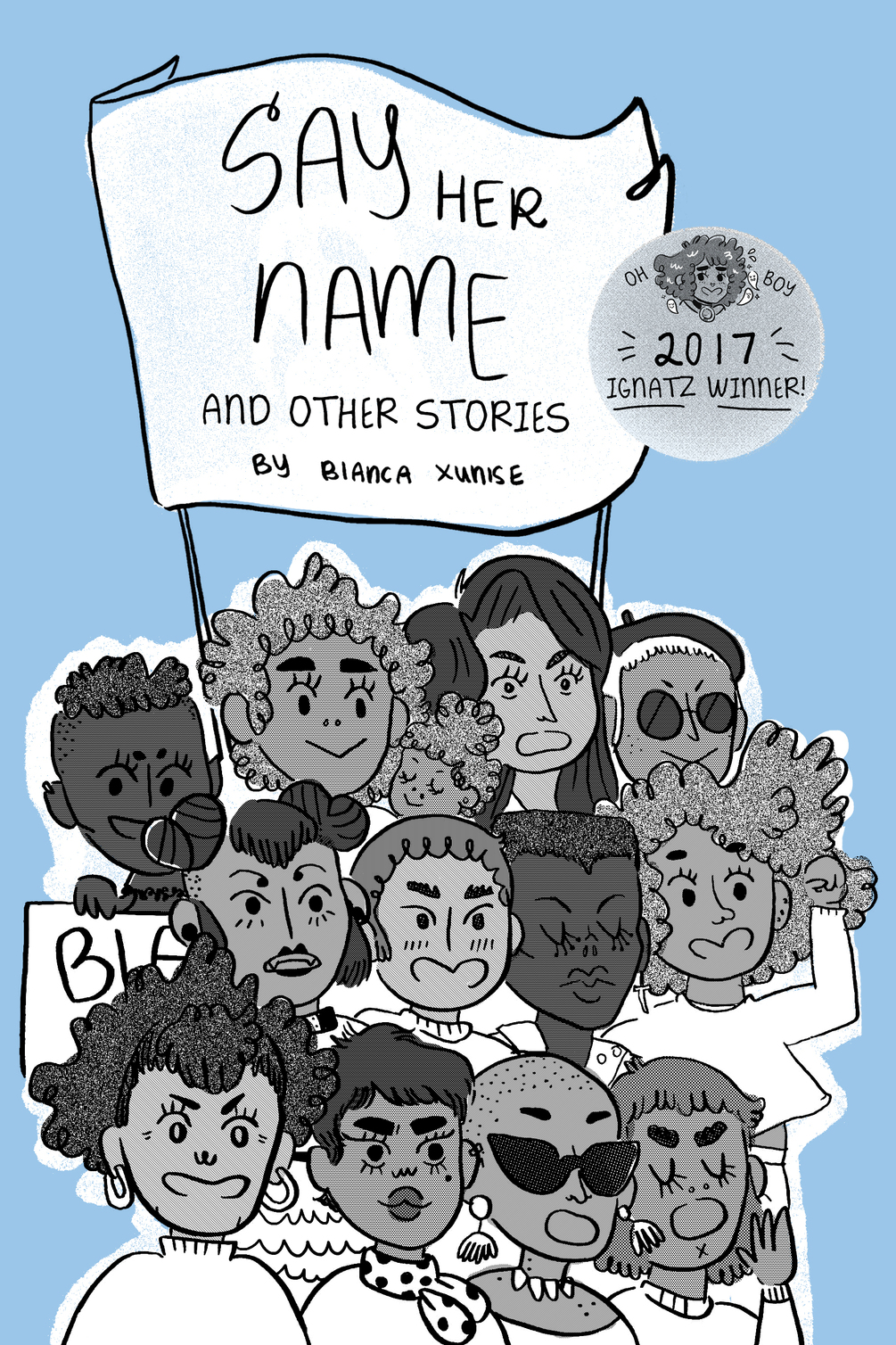
Say Her Name, a 2017 Ignatz winner, contains several short stories in which Xunise uses anecdotes from her own life to illustrate the larger, systemic issue of racism in America. The first story relates Xunise’s fears for her brothers in the wake of the shootings of young men like Michael Brown, Trayvon Martin, and Philando Castile, as well as her father’s run-in with a police officer who mistook him for another Black man. She discovers that even she, model citizen though she is, is not immune to the judgments of the police. She also details an incident of microaggressions around Halloween, and the time her childhood friend levied a slur at her, effectively ending their friendship.

Xunise learns as a teen that her own mother had a similar experience when she was young, common ground that has likely existed between Black parents and their children for generations. Xunise’s relationship with her mother seems complex, and she touches more on her mother’s parenting style in The Devil’s Music, where she reveals her mother’s preoccupation with her return to the Christian church. This dedication to her religion meant that Xunise’s mother did not allow secular music in the house — unless it was from her own childhood. This seems like an unlikely origin story for a person with so much pop culture knowledge, but it is Xunise’s deep understanding of music history that drew me to her work in the first place.

To that end, I was very drawn to Rock Against Racism, which appealed to my interest in music and history. Somehow, I came in to this mini not knowing much about the Rock Against Racism movement (just a passing reference here and there), and Xunise lays out the basics in a clear, engaging way. She reminds readers that music has always been political, for better or for worse. Beginning with the story of a drunken hate speech from Eric Clapton in 1976, Xunise then launches into the various counterculture music movements that sprung up in the 70s and 80s. I especially appreciate the way she highlights musicians of color who are too frequently overlooked in such overviews of music history. I know that I am guilty of not paying attention to such artists, and Xunise’s brief profiles of artists like Mona Baptiste, Pauline Black, and Steel Pulse (as well as her discussions about them and others on Twitter) have inspired me to dig a little deeper when looking for something to listen to.

After all, music is the main reason I started following Xunise. I was really excited to read GothThrob Magazine #1, which talks about her various gothy loves. Included in this list are Dave Vanian of The Damned (pictured on the zine’s cover), the Mothman, and the Chicago goth scene itself. The tone of this mini is much lighter than the others, a sweet indulgence that moves beyond Xunise’s worries and woes to her joys. She makes a point to talk about two incredible Black woman musicians who helped shape rock music: Sister Rosetta Tharpe (one of the first musicians to play the electric guitar way back in 1945) and the exuberant Poly Styrene, of the punk band X-Ray Spex. Xunise is flexible in her definition of punk music to being more about pushing against the system that solely focused on a style of music, a philosophy which I share and am glad to see touted by an artist I respect so much.
Recently, Xunise hosted a “Comics as Resistance” workshop with The Believer, which you can watch here. If you do watch, I encourage you to support her Patreon. Using comics as a form of protest or resistance highlights Xunise’s background as a person in the alternative scene, conjuring up images of punk zine fests. Though Xunise definitely fits into that category as a punk creator, I would say that in many ways her work bridges a gap, pulling readers into her orbit who might not otherwise have experience in the goth or punk arena with her incredible ability to reach out authentically to her audience. Once again, it is her deep knowledge and openness of heart that keep me coming back for more of her work. I will absolutely be keeping a close eye on her career; I can’t wait to see what she has on the horizon!
The Black Creator Spotlight Series
I started this blog with the express intention of highlighting the comic works of marginalized creators, of lauding the works of women, queer folks, and people of color. The recent conversations around racism in the United States have left me with the realization that I have grown complacent in my coverage, and have not done my part in reviewing the works of Black creators. My expertise is around manga, a comic medium that comes from Japan and therefore is authored chiefly by Japanese creators — though often filtered through the translations and editorial work of white people. But when I consider how I can use my skills to help the conversation about anti-Black racism moving, I keep coming up with my writing about comics.
And so, I want to introduce a new type of column to this blog, where I consciously choose to highlight a specific Black comics creator at least once a month. I know that my platform is not huge, but this format helps not only to spread the word, but also to hold myself accountable to read Black-authored comics. No matter how diverse I think my shelf is, it has been humbling to dig deeper and realize that an overwhelming number of my favorite “diverse” comics are authored by white folks. And while I don’t think there’s anything wrong with white people writing about diverse characters (in fact, I think it’s overall a good thing), it’s not the same as reading works by creators of color, who also deserve to be heard.
My goal in featuring Black creators, as opposed to individual works by Black artists, is to make readers more aware of the creators themselves and go and support those individual creators. For these posts I will not be using my affiliate links, but rather links to the creators’ personal websites, shops, Patreon/Ko-Fi accounts, and so on. I will use this introductory post as a sort of index, updating it with links to each post as I write them.
Read and support Black comics creators.
Black voices matter.
Black Lives Matter.
The Series:
Bianca Xunise
Ronald Wimberly
Comics Lockdown: Middle Reader Mayhem
So many articles on comics out there in the world begin with “Comics: not just for kids anymore!” to a point where it’s eye roll-worthy. This need to brush the “kiddie fare” under the proverbial rug is not only obnoxious, but also disingenuous. There are lots of comics for kids — and they’re great, even for adults. “All ages” doesn’t mean it’s baby stuff, it means it’s interesting to readers of all ages.
I’m not going to put Raina Telgemeier or Dav Pilkey on this list, because I suspect that if you have children, you’re already quite familiar with these industry heavyweights. What I’m hoping to give you is the goods from some equally worthy but less well known creators, to help get your kids through the trying times between Dog Man books.
I’m referring to these comics with the publishing industry term “middle reader,” or “middle grade,” which designates books for children between the ages of eight and twelve. Middle reader is not a genre, so these books will range in the types of stories being told. I may well include some middle reader comics on other, genre-themed lists later down the line, but I wanted this to be a helpful guide for parents who are looking for age-appropriate material for their young readers. Middle reader books, both in comic and prose form, are some of my favorite books. They are so often fun, imaginative, and inspiring, even now that I’m an adult with a child of my own.
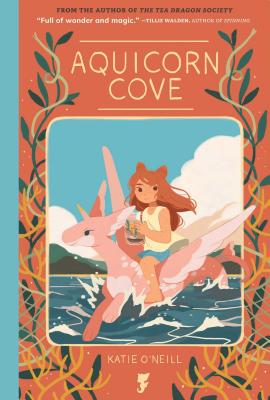
Aquicorn Cove, by Katie O’Neill — published by Oni Press
I wrote last week about how much I love Katie O’Neill’s work, much of which falls under the middle reader category. Of all her works, I think Aquicorn Cove is my favorite. It tells the story of young Lana, who is at the seaside visiting with her aunt and helping to clean up the wreckage in the aftermath of a horrible storm. While there, she finds a young, injured aquicorn, a magical sea creature similar to a sea horse. She nurses it back to health and then discovers that there is a whole colony of aquicorns under the sea, and another storm on the horizon forces her and the community to think about the ways in which people and the environment can learn to coexist. I’m a really easy mark for children’s stories about environmentalism (my favorite Dr. Seuss book is The Lorax, I’m sure you’re surprised to discover), and O’Neill does a great job of getting that message across without condemnation. And of course, there’s her beautiful artwork throughout, along with her inventive creatures and the inclusion of a character who uses gender-neutral pronouns. All around, a really stellar comic about compassion and community.
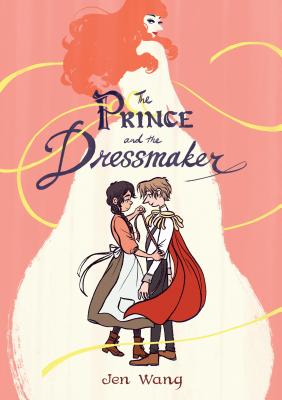
The Prince and the Dressmaker, by Jen Wang — published by FirstSecond
The Prince and the Dressmaker probably doesn’t need my help, as it is currently awaiting a movie adaptation. But I love it, and so I want to share it with you. While Prince Sebastian’s parents are busy trying to find him a bride, he’s preoccupied with hiding a part of his life that he believes they will find shameful. Sebastian enjoys wearing dresses and going into the town as Lady Crystallia, a most fashionable young woman. To this end, he employs Frances, an extremely talented dressmaker who swears to keep his secret and make him the belle of every ball. Sebastian’s secret does get out, of course, but he learns how to be honest with himself and his family at the end. And Frances is able to further her own goals and career, as well. This is a sweet story of love, friendship, and acceptance, and I’m really excited to see what comes of the adaptation.
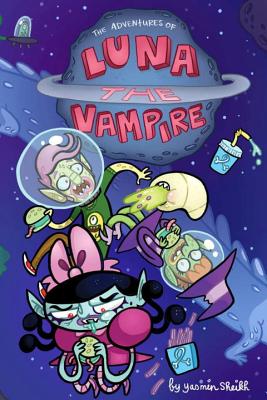
The Adventures of Luna the Vampire, by Yasmin Sheikh — published by IDW
I love weird, gross-out humor involving monsters. Luna the Vampire is such a series, with Grumpy Space (linked above) and Pickled Zits comprising its print editions thus far. Luna is a grouchy, lazy vampire girl who lives in space and has remarkably normal adventures — which is to say, normal for her. She attends her uncle’s zombie-fication ceremony, adopts a fat worm that was intended to feed giant spiders, and clears a raucous party out of her coffin-shaped ship with the help of Kir, the pet store clerk who seems to have fallen in love with her. It’s silly nonsensical fun wrapped in a pink ribbon, and I especially like it because it’s the type of humor usually marketed to little boys but which clearly has young ladies in mind — though I would recommend this for the older end of the middle reader spectrum, with the acknowledgement that it might be for a more worldly-wise kid.

Making Friends, by Kristin Gudsnuk — published by Scholastic
I was immediately in love with Kristin Gudsnuk’s work back when individual issues of her comic Henchgirl were coming out. Maybe it’s because she and I are approximately the same age, but I find her subtle references to anime just really get me. Making Friends makes use of this tendency of hers, as protagonist Dany inherits a magical sketchbook from her great-aunt which allows her to bring to life anything she draws within it. She finds out about this by sketching the head of her favorite comic book/cartoon villain, and when that head pops into existence, she realizes that she can navigate some of the anxieties of 7th grade by creating her own perfect best friend, Madison. Dany learns a hard lesson about facing consequences, but she also makes a lot of real friends along the way. Plus, there’s a magical girl sequence. What can you want more out of a comic than magical girls, I ask you? There is a sequel, Making Friends: Back to the Drawing Board, which I admit I have not yet had the pleasure of reading. But it seems like Dany hasn’t finished learning her lessons when it comes to magicking things into existence!
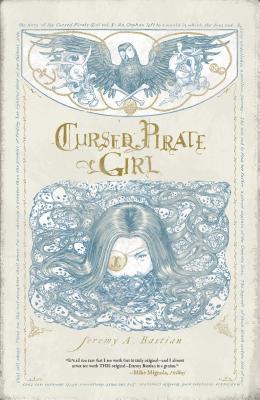
Cursed Pirate Girl, by Jeremy A. Bastian — published by Archaia
My heart races whenever I look at Jeremy Bastian‘s exquisite artwork. I adore Cursed Pirate Girl, though I will warn you that the one volume does not contain the full tale, and it’s hard to know when new material is available. (There was an annual a few years back, if you can track it down!) Still, it is an incredibly beautiful and deeply captivating book where a young girl is on an adventure in the Omerta Seas to find her father. But of course, she’s cursed. Treasure Island meets Alice in Wonderland, albeit with a brash, brave little girl protagonist with hair longer than her whole body. Bastian clearly takes cues from 19th century illustrators, and his incredibly detailed ink work leaves a lot of territory to explore. This is the book for the kid who dreams of magical adventures, possibly ones which involve sentient skeletons. I’m currently reading the second book in Catherynne M. Valente’s Fairyland series of novels, and I think it’s got approximately the same vibe; they both certainly transport me completely to my girlhood fantasies.
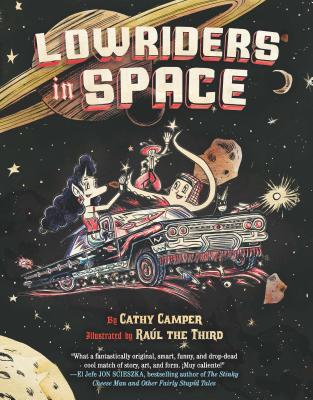
Lowriders in Space, written by Cathy Camper and illustrated by Raúl the Third — published by Chronicle Books
If the title of this book gets War’s “Low Rider” stuck in your head, well…that’s been me all week. In all seriousness, though, this is another lushly illustrated comic which follows Lupe Impala, El Chavo Flapjack, and Elirio Malaria who dream of running their own garage. They catch wind of a car contest and know that they’ve gotta trick out a lowrider of their very own in order to win the cash and start their garage. They manage to fly their work in progress right into space, where they wrangle the stars and upholster their ride in red-Mars-dust velvet. One of my favorite things about this comic and its sequels (Lowriders to the Center of the Earth and Lowriders Blast from the Past) is that Raúl the Third has drawn the entire thing in ballpoint pen. It’s a great testament to using what you have to make incredible art, and the story itself is a gorgeous homage to lowrider culture. Just don’t be surprised if you suddenly wish you had a car that was bajito y suavecito!
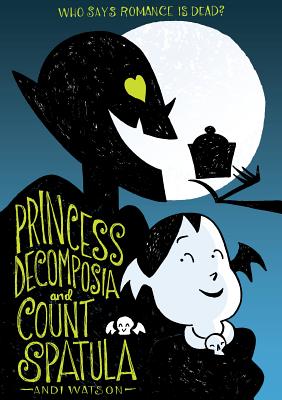
Princess Decomposia and Count Spatula, by Andi Watson — published by FirstSecond
It should surprise no one that this title popped out at me when I saw it on a shelf at Comicopia in my first year working there. Princess Decomposia is the daughter of the King of the Underworld, but that job isn’t as glamorous as it sounds. She has a lot of responsibilities, and unfortunately is forced to shoulder those of her father most of the time, as well. Seeing as he just fired the cook, she has to hire a new one immediately — and thus we meet Count Spatula, the vampire chef with an unrepentant sweet tooth. The two become fast friends, though a budding romance has to take a backseat to Princess Decomposia’s many tasks. This is a cute little volume about love blooming in spooky darkness, for the little Wednesday Addams in your life.
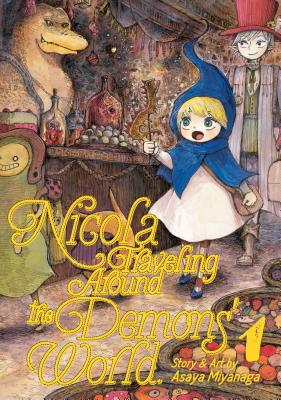
Nicola Traveling Around the Demons’ World, by Asaya Miyanaga — published by Seven Seas Entertainment
I’ve written about Nicola before, both here on the blog as well as for Comics Beat. It’s a delightful adventure where little witch Nicola, who has recently stumbled into Hell, has latched onto Simon, a traveling merchant. The two form a sort of father-daughter bond, and Simon becomes increasingly impressed with Nicola’s emerging magical talents — though she does not seem to notice her own powers herself. I felt so good after reading the first volume, like here was something that truly deserved being called “all ages,” something I could recommend to everyone without reservation. I love Asaya Miyanaga’s artwork, with its detailed hatching and whimsical creature designs. The physical copies of the book are printed in sepia ink, making the book something truly special.

Kitaro, by Shigeru Mizuki — published by Drawn & Quarterly
I will never stop singing the praises of Shigeru Mizuki, whose comics about the adorable little monster boy, Kitaro, are so specifically my jam that I’m amazed they first came out before even my mother was born. Along with help from his father, Medama Oyaji (who is literally a giant eyeball with a tiny body), Kitaro helps settle disputes between monsters and humans. There are several volumes of the series out right now, but they are grouped by type of story instead of in any sequential order; I have linked to The Birth of Kitaro as my recommended starting point, since that’s where you learn our hero’s backstory. Translator and Mizuki expert Zack Davisson has written excellent informative essays in each of these editions, and those do follow an order. It’s a great way to learn more about the man who was Shigeru Mizuki, as well as the vast world of Japanese yokai — a subject very dear to my heart. If you or a kid you know are really into sympathetic monsters, potty humor, and/or the history of manga, I can’t recommend this enough.
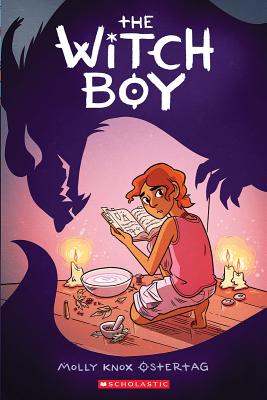
The Witch Boy, by Molly Knox Ostertag– published by Scholastic, Inc.
I just love witchy stuff for kids. In this coming-of-age story, Aster wants desperately to be a witch. Unfortunately for him, only girls in his family become witches, while boys become shapeshifters — though he has not shifted yet, himself. Aster has to study in private, eventually using his hard-won abilities to help rescue the other boys when a dark entity threatens them. This is a wonderful story for those who have ever been made to feel different or wrong when they choose to be themselves. This is the first book in a trilogy, the other books being The Hidden Witch and The Midwinter Witch, which continue to follow Aster’s studies in witchcraft while expanding the cast, further exploring the challenge of bucking against tradition.
There sure are a lot of witches, monsters, and royalty this week. I told you middle readers get some of the best books! It was actually difficult to come up with this list because there’s so much good material out there, and still so much that I haven’t had a chance to read yet. I’m continually impressed by the quality marriages of story and art that exist in comics, but especially in comics “for kids.” I would absolutely recommend looking deeper into your library’s catalog for comics for this demographic, as I personally know a lot of librarians who cannot get enough of helping kids (and their parents!) find their next favorite read.
Until next week, I hope you all stay safe and well!
Comics Lockdown: Reading With Little Ones
Even before Severina was born, I was a big fan of books for children. While I was pregnant, we read to her in my belly, and we’ve been reading to her ever since she was born — regardless of the fact that she’s only now even starting to notice the pages in earnest. I believe that reading to children is the cornerstone of kindling their love of literature, and that reading is not only good for its own sake, but for fostering empathy and giving kids a quiet, personal activity for when they need alone time.
To that end, I’ve played a little fast and loose with my definition of “comic” here, since picture books are a sequential art in and of themselves — and I like them, besides. I have tried to stick with authors who also write “comics” at the very least, so that this list can act as an introduction to creators whom little readers can revisit later in life. This list will be for children from birth through early elementary school; I’ll do middle reader and young adult comics lists later on. I would emphasize that even if you think your child isn’t getting anything out of reading, they’re learning and retaining more than you think!
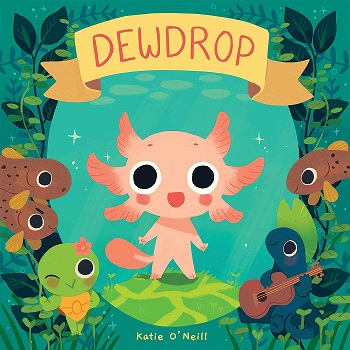
Dewdrop, by Katie O’Neill — published by Oni Press
I’m a huge fan of Katie O’Neill’s work, ever since the print version of her comic Princess Princess Ever After came out. I even had the privilege of meeting her when she was Stateside for New York Comic Con a couple years ago; she was kind enough to do a signing at Comicopia. She’s extremely sweet, exactly the kind of person you would imagine writes and illustrates excellent material for kids — which she does! Dewdrop is her newest book, which follows a little axolotl as he encourages his friends, all of whom are lending their unique talents to the annual sports festival, to be the best they can be. The only text in the book is word bubbles, giving the full comic experience to even the youngest of audiences. Katie’s lineless artwork is bright and composed of simple shapes. One of my favorite aspects of her work is the focus on kindness, both toward other people and toward the planet. There’s more information at the back of this book about the animal characters, providing a little ecology lesson along with a gentle tale about helping your friends recognize their talents.

You Are New, by Lucy Knisley — published by Chronicle Books
I’ve mentioned Lucy Knisley’s latest picture book in a past iteration of my monthly favorites, but it bears repeating. Like Katie O’Neill, Knisley opts to forego lines in favor of bright, bold shapes for little eyes to take in. This book focuses on all the situations in which we are new: new as babies, new as older siblings, new to a school, new when we recreate ourselves in our imaginations, and so on. It’s a lovely early introduction to change, and how exciting it can be when we look at it as an experience of newness. I think that this would be a very good read for a child who is struggling with change — and given the current state of the world, I know a lot of tiny people are having a rough go of it. Change is a common theme in Knisley’s work, much of which draws from her own lived experiences.

¡Vamos! Let’s Go to the Market, written and illustrated by Raúl the Third with colors by Elaine Bay — published by Versify
This book has been favorably compared to Richard Scarry’s Busytown books, which is fair; however, I want to make it clear that ¡Vamos! Let’s Go to the Market and its sequel ¡Vamos! Let’s Go Eat are in a league of their own. Raúl and his partner, colorist Elaine Bay, bring a thriving Mexican market alive for readers, seamlessly weaving in Spanish words and phrases as Little Lobo and his doggy companion Bernabé make deliveries for various market shops. There are both word bubbles and story text, making this a comic/picture book hybrid. Raúl’s dedication to Mexican iconography and obvious familiarity with the comings and goings of the mercado give the bustling scene texture and depth. His artwork, which has graced everything from beer cans to gallery walls, is a gorgeous cartoon-meets-desert-fever-dream, and it’s exciting that even the youngest of readers can enjoy it.
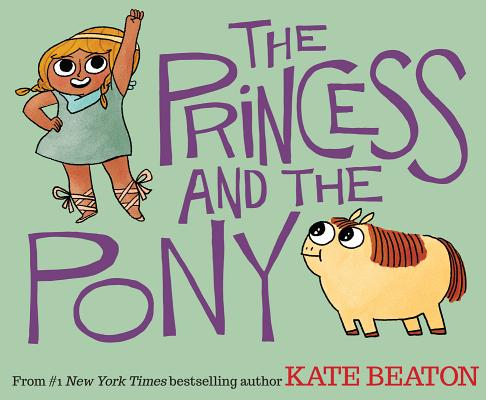
The Princess and the Pony, by Kate Beaton — published by Arthur A. Levine Books
Years before Kate Beaton had a baby of her own, she made a couple of excellent picture books which I have enthusiastically gifted to friends and family over and over again. The Princess and the Pony is the story of Princess Pinecone, a warrior princess who dreams of acquiring a mighty steed to help her in her conquests. Instead, she receives a chubby, flatulent pony with an absurd face. Hilarity ensues, as it so often does under Beaton’s expert pen. Get your giggles and spark a love of weird little girls (and their weird pets) in fiction.
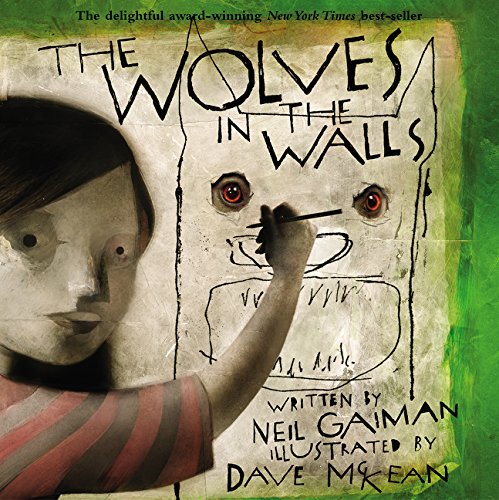
The Wolves in the Walls, written by Neil Gaiman and illustrated by Dave McKean — published by HarperCollins
I’m pretty sure Neil Gaiman has written every sort of thing possible, and that includes a bevy of books for children. My favorite of them is The Wolves in the Walls, wherein young Lucy tries to warn her family about the wolves living in the walls of their house. They dismiss her claims, all of them reciting that “When the wolves come out of the walls, it’s all over.” Of course, the wolves do come out of the walls, and it is Lucy who must decide to take her home back from the partying canine invaders. It’s a very silly book with Dave McKean’s spooky and wonderful collage artwork. I love the way he draws almost elastic-looking wolves in ink, sleeping in Lucy’s bed and eating Lucy’s mother’s homemade jam out of the jar. This book might not cut it for a child who is easily frightened by confusing or dark imagery, but for the kid with a sophisticated sense of humor, it’s a good bet.

Monster School, written by Kate Coombs and illustrated by Lee Gatlin — published by Chronicle Books
This is one of those (many) circumstances where I bought a children’s book long before I was even considering getting pregnant because I was a fan of one of the people involved in its production. In this case, I follow artist Lee Gatlin, whose spooky and adorable comics first caught my attention many years ago, probably recirculated on Facebook or something. Monster School is an excellent use of Gatlin’s darkly adorable art style, and the poems by Kate Coombs convey a nighttime school experience that many kids would die for — literally, in the case of one sweet little ghost. What’s more, the poems are fun to read, and they utilize many different poetry formats, giving readers lots of rhyme schemes to try out. I read this to Sev recently, and while she probably didn’t understand a lick of it, I was very impressed and believe it will become a family favorite!

Zombie in Love, written by Kelly DiPucchio and illustrated by Scott Campbell — published by Atheneum Books for Young Readers
I’ve been really impressed by how many high-quality “spooky” children’s books we’ve been able to acquire. This one was a gift, along with its sequel Zombie in Love 2+1, and I instantly recognized artist Scott Campbell from his Great Showdowns illustrations. Campbell’s watercolors expertly accompany the story of Mortimer, a lonely zombie who has been trying desperately to find his true love. He’s tried every piece of advice he can find without luck, until he finally stumbles upon his match at the Halloween ball! The sequel follows Mortimer and his love Mildred as they become new parents to a living human child, with all the ups and downs of parenthood. These are absurdly sweet, funny books with a touch of the macabre to keep things weird, and plenty of zombie jokes hidden in Campbell’s artwork.
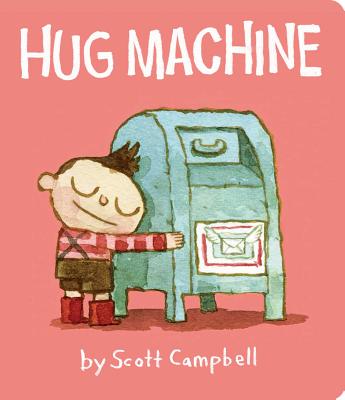
Hug Machine, by Scott Campbell — published by Little Simon
Scott Campbell gets two books on this list, but I couldn’t resist another favorite gift — and he’s both writer and illustrator this time. Hug Machine is told from the perspective of a child who is an excellent hugger. He hugs everyone and everything, and is fueled by pizza. This one is a board book, so a great read for little ones who are enthusiastic about demonstrating affection, but haven’t yet mastered not putting books in their mouths!

Chi’s Sweet Home, by Kanata Konami — published by Vertical Comics
Manga is actually a challenging ask for very young kids. Most of what gets translated is intended for at least a middle school audience, though Japanese picture books like Everyone Poops have been childhood classics for decades. Chi’s Sweet Home is the one manga I always felt comfortable recommending to families with little kids. It’s a very simple tale of Chi, a little cat who lives with a family and gets into various mundane troubles. Big-eyed Chi is instantly appealing to little ones, and the low-stakes situations make for innocent fun. The manga now comes in large omnibus editions, so this is a tough grab for little hands. But for a family read-along, this is a great pick that will really throw kids into the world of comic books.
Every day, I find more books that I want to add to Severina’s library. My mother-in-law likes to joke about how she had to read The Poky Little Puppy over and over again to my husband, but we are very lucky to be living in a time with an overwhelming wealth of excellent children’s literature to suit all tastes. I can’t overstate how important I think it is for adults to read to children, and I hope that even in the chaos of quarantine, those of us who share our homes with kids are granted some time to have that experience.
Next week, we’ll be talking comics for older elementary and middle school aged children. This is a HUGE market in graphic novels, so it should be fun to try and come up with some hidden goodies buried among the mountain of bestsellers.
Until then, happy reading!
Comics Lockdown: A COVID-19 Reading List Series
For the past two months, much of the world has been in a state of lockdown, self-isolating because of the rapid spread of COVID-19. In the midst of all this, I have been wondering how I could reach out and help people find some comfort while they remain apart from friends, family, coworkers, and their normal daily lives. While it’s true that listicles of what to read in quarantine are abundant on the Internet right now, I thought I would try to share my own perspective with some themed lists of suggestions, especially since it seems like we’re all going to be keeping physical socializing to a minimum for a while yet.
My plan is to break the lists out into age groups and/or genres, in order to make them more easily digestible in one sitting. In my posts, I will be linking to Bookshop.org in case readers wish to buy the book in question. I also encourage readers to buy from their local independent comic or book shop if they don’t want to use my links, or to borrow from their local library. Many libraries are currently offering a more robust selection of ebooks, including graphic novels and comics, through Libby, Overdrive, and/or Hoopla. You can visit your library’s website for more information on how to access those apps, and I believe many libraries are also able to issue online-only library cards if you need one.
I know these times are challenging, and sometimes finding more tasks with which to occupy yourself can feel overwhelming. I don’t believe we should all be striving to be more productive right now; this virus has highlighted some major flaws in this country’s established operations, and it’s important to interrogate our need to be “useful.” But I do think that many of us, myself included, take comfort in books — and in this case, in comics. I hope that we are all able to find what we need right now, whether that be escapism, education, solidarity, or a call to action.
Above all, I hope we are all able to remain safe and healthy, and that we are able to return not to normal, but to an improved society that recognizes the importance of community and connection.
Happy reading!
The Series:
Reading With Little Ones
Middle Reader Mayhem
Hallowmangaween!
Halloween is my favorite holiday. As far as I’m concerned, it’s a month(s)-long revel in the joys and fears of mortality, capped by the actual three-day event (Halloween, All Souls’ Day, and All Saints’ Day — I was raised Catholic!). And every year, I tell myself I’m going to experience it to its fullest and be the absolute Halloweeniest I can be — which is almost always derailed by being involved in one too many other activities.
One of my intentions every year is to write about Halloween-appropriate manga, meaning outright horror fare, as well as titles that just generally get into the Halloween spirit. When someone asked me recently on Twitter if I was going to do a horror post for October, I realized that I really had to stop procrastinating and give it a go. And so here we are.
There are countless manga that work in a round-up like this, and countless in-depth pieces that can be written about each of them, surely. For the purposes of this year’s attempt, I’m going to pick out some of my absolute favorites and separate them into different categories in an effort to make this all easy to digest. I hope that this list provides you all with some spooky reading to accompany your horror movie marathons, costume balls, haunted hay rides, cider-sipping, candy-scarfing, and general creepy merriment!
Monster Children
As a society, we’ve decided that children are scary. They pop up in horror films both in Japan and in the West, eerie because of their unpredictable nature and the lack of reason and logic that governs an adult mind. The monster children of the manga I’ve chosen are a little different, operating more as either moral guides or as helpless, sympathetic figures who have unfortunately lost their way or been made to perform bad deeds. I’m particularly fond of this kind of narrative, which asks the reader to consider what exactly it means to be a monster. Very Frankenstein, but with the added bonus of using children for maximum emotional manipulation!
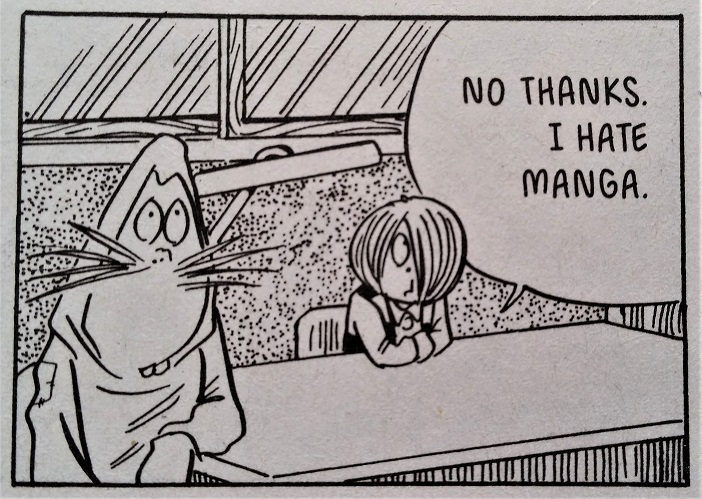
Kitaro, by Shigeru Mizuki — published by Drawn & Quarterly
Shigeru Mizuki’s classic tales about little Kitaro, last of the Ghost Tribe, are truthfully not very scary. But they are wickedly fun, reveling in a world populated by yokai and monsters of many cultural origins. Kitaro, with help from his father, the walking eyeball Medama Oyaji, and a motley cast of yokai, seeks to rid humankind of cruel, greedy, or evil yokai. He is a superhero of sorts, one who lives between the world of the living and the world of the fantastical. Originally intended for younger readers, the Kitaro stories are rife with silly gags and cartoonish characters, laid over the lush background settings meticulously penned by a one-armed Mizuki. In fact, the legendary mangaka is credited for single-handedly bringing yokai back into the modern consciousness after the Second World War, and I highly recommend seeking out his other yokai-related works. I have a copy of his yokai artbook — a beautiful gift from my husband — which nearly made me cry with its beauty. As a creator, Mizuki embodies several of my favorite things: a love of the strange, an eye for the beautiful, and a willingness to have fun — and to tell poop jokes.
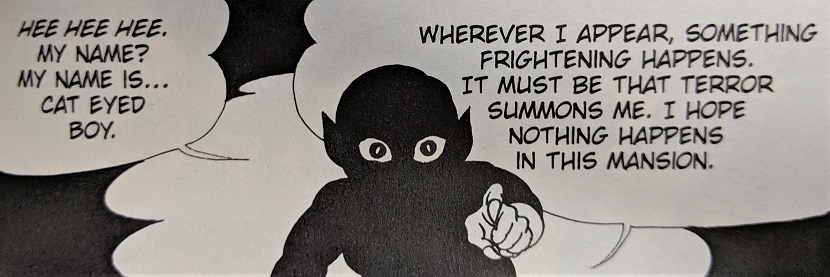
Cat-Eyed Boy, by Kazuo Umezu — published by VIZ Media (out of print)
With the gorgeous hardcover reprint of The Drifting Classroom so fresh in everyone’s minds, I want to draw attention to my favorite of Kazuo Umezu’s works. Cat-Eyed Boy is a very me manga, starring yet another cheeky monster-child who gets tangled up in the lives of humans. Like Kitaro, Cat-Eyed Boy finds himself rescuing people more often than not, but rarely is he appreciated for his efforts. He’s not well-liked by humankind, doesn’t really fit in with other monsters, and has an all-around salty attitude toward everyone. And he’s precious. Umezu, known for both his horror and his gag manga, combines the two disciplines well in this series. His monsters are more threatening than Mizuki’s, the stakes are often higher, and there are fewer neatly-tied story bows. It puts one in mind of early, pulpy horror comics from the West, stuff like Haunt of Fear or Eerie Comics. Really delightfully naughty scary fare for the mischievous little wanker in all of us.
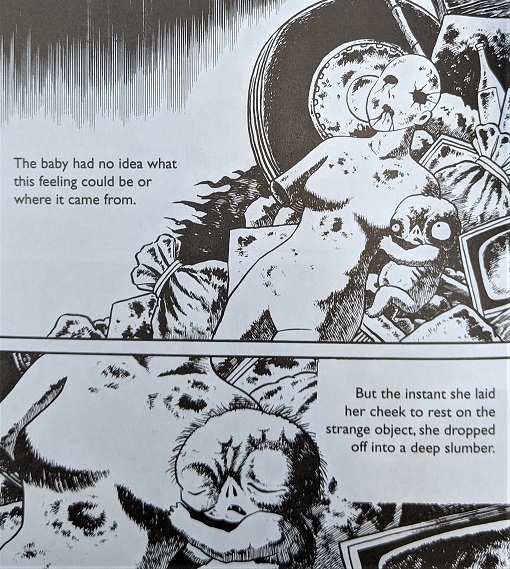
Hell Baby, by Hideshi Hino — published by Blast Books (out of print)
It kills me that there are no Hideshi Hino manga currently in print. I want to recommend him to everyone who loves Junji Ito, a mangaka who has spoken of his great love for both Hino and Umezu countless times. In Hell Baby, twin girls are birthed to an excited couple, but they soon discover that one of them is hideously disfigured. Because the new dad is apparently going to win zero parenting awards, he dumps the offending child in the literal garbage, where she predictably dies. But that is not the end for this strange infant. Spirits merge above the junkyard where her corpse rots, entering it and imbuing it with new life. From there, she grows by eating carrion, drinking ditch water, and slurping up earthworms. She is a monster who grows to wreak havoc on the community, destined to get her revenge on the family and the society who spurned her. But she is deeply sympathetic as well. There are scenes of her snuggling up next to a decaying mannequin in the junkyard that make my heart ache for her. Talk about Frankenstein vibes! Hino’s artwork is gross and wonderful, full of inky blackness and never shying away from the horrors perpetrated against Hell Baby — and by her.
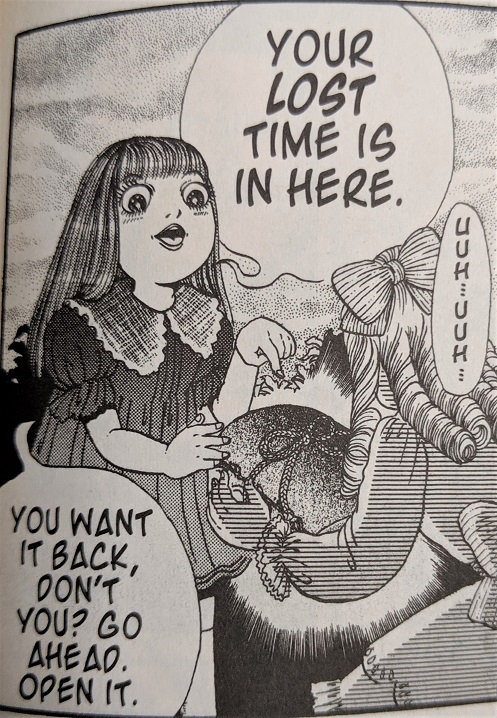
Presents, by Kanako Inuki — published by CMX (out of print)
Another thing we don’t have enough of in North American manga publishing is horror series by women. A couple of Kanako Inuki’s works have come over but are long out of print. Presents could actually fall under “morality plays” too, but because the protagonist, Kurumi, is a child of sorts, it felt right to include it here. Kurumi was never given birthday presents as a child, and because of this has somehow ceased aging. It is her dark duty to wander the world giving presents to others — but these gifts are often more frightening than fun, providing the receiver with their just deserts. Inuki’s artwork is wonderfully bizarre, her characters — nearly all children — squat and bug-eyed, with over-exaggerated expressions. She utilizes a great deal of detail in backgrounds and clothing, placing her doll-like figures in realistic 90s-modern settings. Delightfully fun and creepy, and satisfying in the way it punishes only the deserving while keeping the cursed protagonist as the sympathetic character.
Ghost Stories & Possessions
It can’t be a Halloween recommendation list without ghosts! I took some liberties with what “possession” meant in this category, but basically if it involves haunting or hobknobbing with supernatural entities, and I couldn’t fit it somewhere else, I put it here!
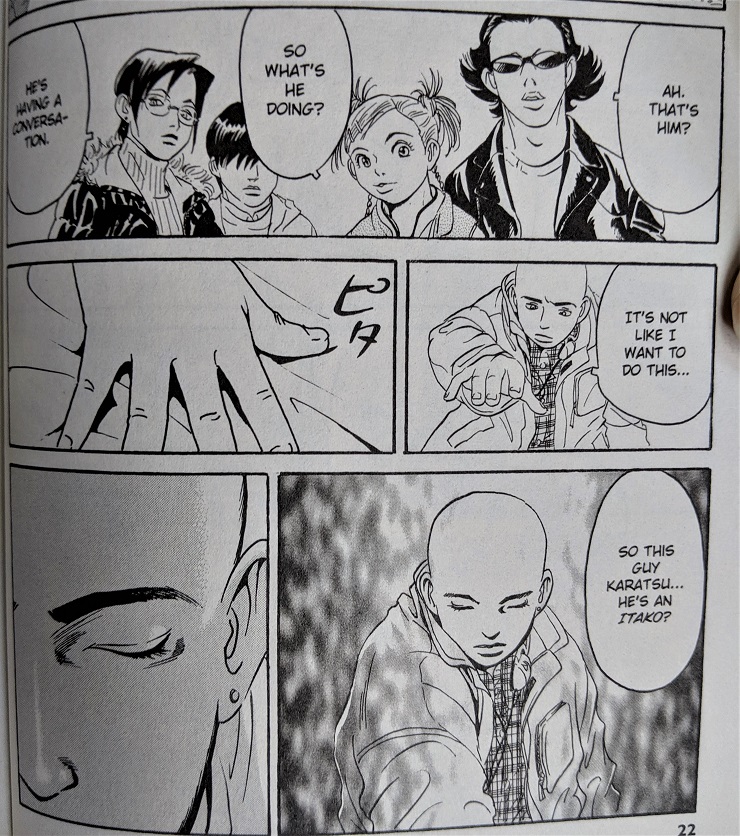
The Kurosagi Corpse Delivery Service, by Eiji Otsuka & Housui Yamazaki — published by Dark Horse Comics
I have the omnibus versions of this manga, and every time I bought a new one I told myself I would only read one single volumes’ worth and save the rest for the next night. And every time I cracked one open, I devoured the entire thing in one sitting! Our protagonists are five students at a Buddhist university, each with their own special skills or abilities, including embalming, hacking, dowsing for spirits, communicating with alien lifeforms, and being able to channel the dead. Through the use of these skills, the group has created a service through which they perform the final wishes of the deceased. It’s an unusual way to make ends meet, but it seems to work for them! I love the mix of laid-back irreverence displayed by students who are supposed to be at a religious school, paired with their dedication to ultimately doing the right thing to help the dead rest in peace. This series is definitely not for the faint of heart, as there are some really disturbing deaths, but Housui Yamazaki’s clean, controlled artwork is a pleasure to look at, no matter the subject. I desperately want more people to pick this series up so that Dark Horse knows exactly what a gem of a manga it is and continue publishing it — so please, give it a try!

The Black Museum: The Ghost and the Lady, by Kazuhiro Fujita — published by Kodansha Comics
I initially bought this series because I was intrigued by the subject (ghosts) and the artwork (which has the air of a vintage series, despite having originally come out in 2007). What I wasn’t anticipating was that it was also an historical fiction series set during the Crimean War and largely starring that most famous of nurses, Florence Nightingale. The story is told in a flashback narrated by the Man in Grey, a ghost haunting the Black Museum who had struck up a sort of deal with Nightingale, who herself was surrounded by malevolent spirits at all times, that he can kill her once she finally succumbs to despair. The series is two volumes long (Kodansha has yet to publish the other volume in the Black Museum series, about Spring-Heeled Jack), and full of rich, energetic illustrations of ghosts, mass (gross) illness, feminine grit, and plenty of dueling!
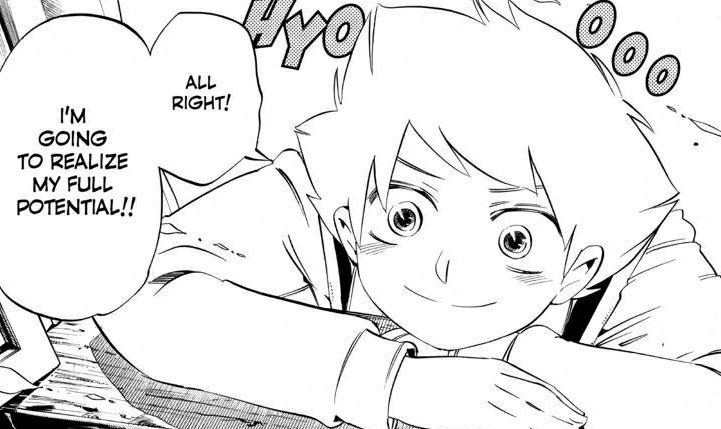
Muhyo & Roji’s Bureau of Supernatural Investigation, by Yoshiyuki Nishi — published by VIZ Media and available in full on their Shonen Jump app
There are a few Shonen Jump series that could potentially squeak by in a Halloween round up (my two favorites, Yu Yu Hakusho and Yu-Gi-Oh! might count as “spooky” on a technicality), but Muhyo & Roji is one of those series that doesn’t get nearly enough attention, and it’s strictly about ghosts, exorcisms, and general spookiness! When I started reading this series through the then-new Shonen Jump app, I thought it was going to be an episodic monster of the week type deal (which I love), but it actually ended up having a very full story line — and an ending! A shonen series with an ending! Muhyo is a young exorcist of immense ability, and Roji is his apprentice. The two are tasked with exorcising malevolent spirits, but eventually they get dragged into a more earth-shattering issue when a former classmate of Muhyo’s becomes possessed by an evil entity. I simply adore Yoshiyuki Nishi’s inventive and weird creature designs, as well as the relationship between the two main protagonists. (Muhyo shows his affection mainly through being ornery, which is a weakness of mine!)
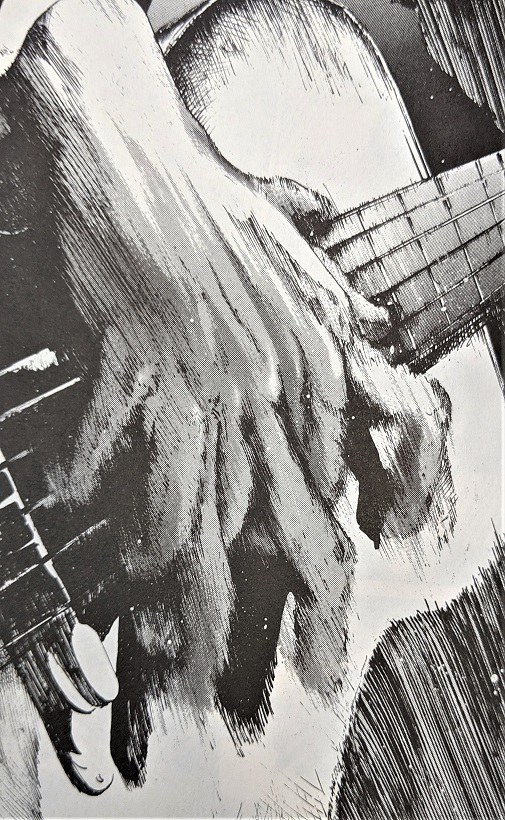
Me and the Devil Blues, by Akira Hiramoto — published by Del Rey (out of print)
I had a hard time deciding which category to fit this manga under, but I wanted to make sure I mentioned it. Another historical fiction series, this one was penned by Akira Hiramoto, best known currently for Prison School — but the two series couldn’t be any more different. The manga is named after the song by blues legend Robert Johnson, who is mythologized as a man who sold his soul to the Devil in order to play guitar in the unique way that he did. Hiramoto has decided to play with that myth, depicting Johnson as a man possessed with infernal ability. The result is a gorgeous, dark, angry depiction of the American South that is surprisingly adept with its awareness of race relations and the struggles of a young black musician in the 1920s and 30s, considering it was made by a Japanese man in the 00s. I definitely want to give a warning for violence and offensive language, as the subject matter comes with a lot of baggage related to Jim Crow laws. Hiramoto utilizes an incredible breadth of artistic abilities in this manga, with chapter headers often done in charcoal or graphite, and certain sequences portrayed in brush work instead of pen and screentone. It’s a real gem of a manga, and it’s a shame that it’s out of print and hard to find. If you love gritty Southern Gothic tales, this is a good pick for sure!
Morality Plays with Beautiful Art, Beautiful Men, and Plenty of Mind-Breaking Horrors
You all must know by now that this is one of my absolute favorite genres of fiction, between my writing about it here in the past and tweeting about it all the time. But I’m such a sucker for a mysterious entity doling out prizes or punishments to the deserving (or undeserving) masses. I’m that lady who has The Twilight Zone theme song as my ringtone, so there should be no surprise about my tastes, haha. In recent years, I’ve been able to find a few more examples making their way into English, so I want to share them!
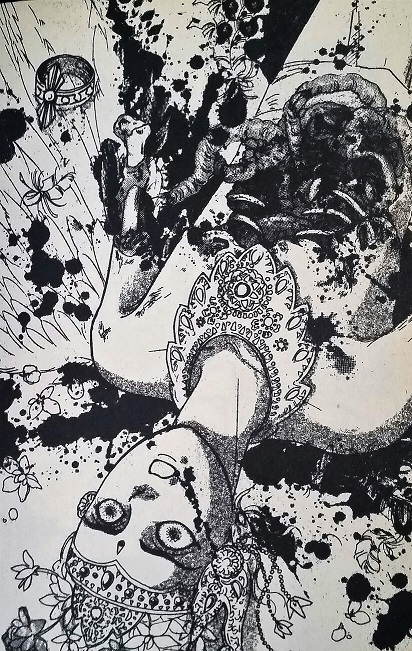
Pet Shop of Horrors, by Matsuri Akino — published by Tokyopop (out of print)
Okay, I wrote a whole long love-letter to Pet Shop of Horrors earlier this year, and everything I said there still stands. This was the manga that started it all for me, with gorgeous art offset by horrifically detailed punishments. For those unfamiliar, Count D is the proprietor of a pet shop in Los Angeles’s Chinatown, where he provides rare and exotic animals to those seeking something beyond a mere cat or dog. Detective Leon Orcot of the LAPD is determined to bust the Count for operating a drug ring or being involved in some other kind of illegal behavior, but instead he is drawn into the mysterious world of animals who are more than what they seem. The series is unfortunately out of print, and its sequel, Pet Shop of Horrors: Tokyo, was never completed in English. You can watch the anime over on Hi-Dive, and while I don’t think it’s quite as entrancing as the manga, it will give you a good idea of the characters and the premise.

Nightmare Inspector, by Shin Mashiba — published by VIZ Media
Soon after starting work at Comicopia, I discovered the existence of Nightmare Inspector and promptly ordered myself the first volume. I was thrilled to finally have something similar to Pet Shop of Horrors in premise; it had been so long since I had read it and I wanted to fill that niche again. Here, our mysterious entity is a baku named Hiruko, who eats the nightmares of the clients of the Silver Star Tea House in an effort to help them work through issues. Hiruko has his own dark past, of course, so there is an ongoing plot that inches forward with each new client’s problems. Shin Mashiba’s artwork is way more cutesy and mid-2000s than Akino’s sublime 90s high shojo work, but that cuteness belies many violent images and intense stories of trauma and fear. Lots of fun, worth picking up if Pet Shop is your thing!
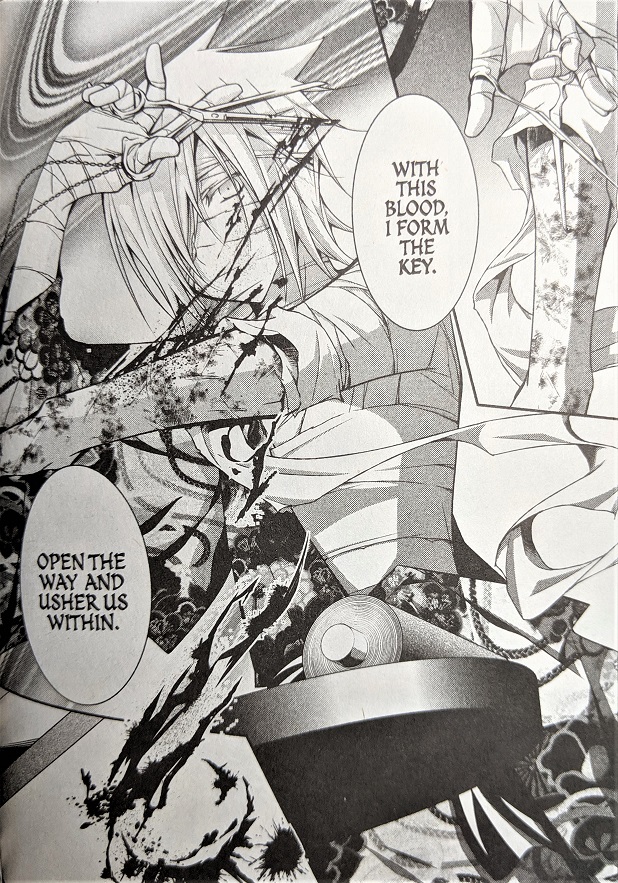
Yokai Rental Shop, by Shin Mashiba — published by Seven Seas Entertainment
Another work by Mashiba! This series came out more recently, in four regular-sized volumes that make it a nice quick Hallowread. In this series, regular old civil servant Hiiragi learns that his half-brother is the proprietor of a pet shop. Said brother, Karasu, is in fact the proprietor of a yokai pet shop, where he forms contracts with various yokai to help his clients meet their needs — often with a hefty price. Karasu and Hiiragi are soon embroiled in their own family fiasco, however, dealing with their cruel yokai father and his desire to create the perfect yokai-human hybrid. Mashiba’s artwork has certainly matured since she wrote Nightmare Inspector, combining digital techniques with traditional. And her monster designs remain creepy and fun, as well!
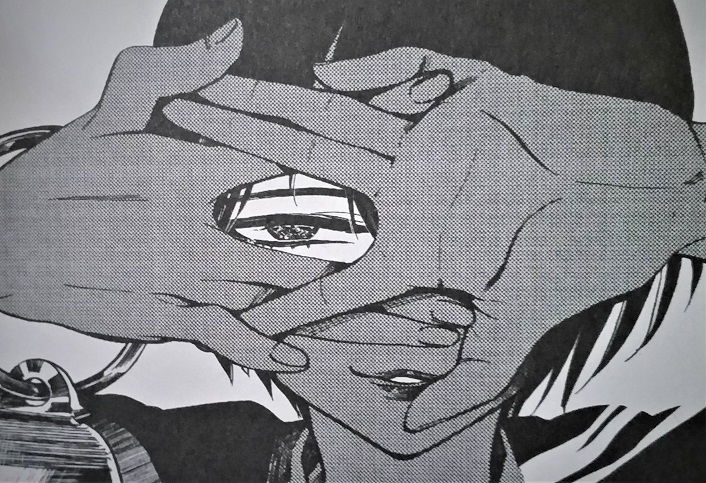
Phantom Tales of the Night, by Matsuri — published by Yen Press
I wrote about this series as one of my favorite reads for September, and I think of the newer morality-play-type works I’ve read, it’s probably the most different. In Pet Shop, Nightmare Inspector, and Yokai Rental Shop, the various mysterious shop owners or supernatural entities are a little chaotic, but generally not outright bad. The proprietor of the inn in Phantom Tales of the Night is definitely more sinister, giving his trading in clients’ secrets a bit of a fearsome edge to it. There’s only the one volume out from Yen Press right now, so I’m looking forward to seeing where this lushly illustrated spooky train of vice takes me in the volumes to come!
Vampires
I love vampires. I can’t deny it. I love gross, hairy-palmed Draculas and beautiful, dramatic, excessively romantic vampires. I don’t really know why, but maybe it’s my love of the theatrical. Either way, I often have kind of a hard time finding vampire fiction I like, even though there’s plenty of it out there, so I get really excited when something I judge as good comes my way.
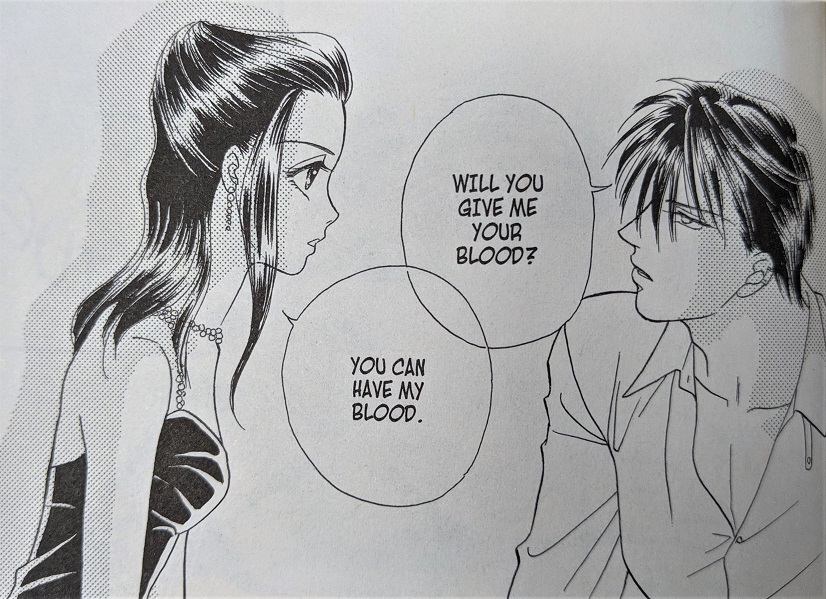
Midnight Secretary, by Tomu Ohmi — published by VIZ Media
This is, perhaps, the “trashiest” manga I like, the most indulgent of romances I can stomach. Our plucky protagonist, Kaya, is a damn good secretary, and she knows it. When she’s assigned to work with her company’s notoriously difficult director, she takes it in stride — until she discovers that he’s a vampire, and that he as a particular taste for her blood. Despite having all the trappings of a Harlequin romance novel, there’s something about Kaya’s stalwart dedication to her job, even in the face of an absurdly steamy vampire romance, that really endears me to it. And this a surprising series in that everyone I know who has read it loves it — regardless of their gender or their other manga preferences. It’s just charming fun, something a little lighter for those of us who want to get into the Halloween spirit but maybe don’t want to indulge in a gorefest.
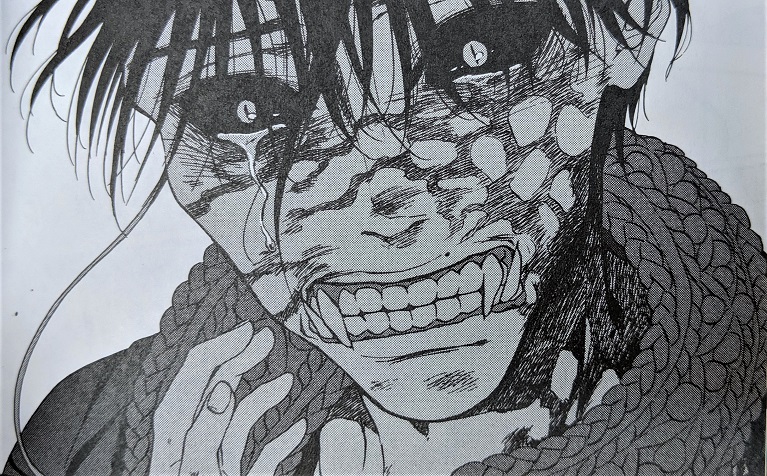
Devils’ Line, by Ryo Hanada — published by Vertical Comics
A decidedly different kind of vampire romance, I like Devils’ Line partially for Ryo Hanada’s penchant for drawing characters with dark under-eye circles — another weakness of mine! But in all seriousness, this story takes place in an alternate modern era where vampire-like people called “devils” co-exist in society but must live under strict rules or else be terminated by special police forces. Anzai is one such devil who works for the police, and in the course of his duties accidentally meets and becomes involved with a young, non-devil, woman named Tsukasa. The two cannot help falling in love with each other, but their romance is fraught with Anzai’s fears about his carnal nature taking over and turning him into a monster who harms Tsukasa. Add in a bunch of government conspiracy, and this is a fun thriller with plenty of blood, action, and a good sprinkling of sex. An anime came out last year, but I didn’t think much of the pilot; I would recommend going for the manga instead.
And with that, I’m calling it quits for now. As I said above, there are countless excellent horror manga — not to mention other horror comics! — but this list has got to end somewhere. You’ll notice that I didn’t bring up body horror (even though I do really like it) or Junji Ito at all. This was partially to keep this already long post a little shorter, and partially because I think, at least in the case of Ito, not much more needs to be said. Most horror fans know about Uzumaki, and with VIZ doing an excellent job of promoting all of his upcoming work, it’s hard to avoid hearing about Ito. It’s worth noting that he actually is one of my very favorite mangaka, so don’t take this as a slight against him, please! I’m just interested in promoting some lesser-known works this time around. I’m sure there will be opportunity to discuss more horror in the future.
I would like to wish you all a very happy, haunted, horrific Halloween! Have fun, indulge in sweets and spooky media and pumpkin spice! And don’t forget — Halloween can be every day if you so choose. ;3
